Abstract
1. The effects on micturition of RP 67,580, a selective NK1 receptor antagonist, and SR 48,968, a highly, potent antagonist at NK2 receptor sites, given intrathecally (i.t.) or intra-arterially (i.a.) near the bladder, were investigated in unanaesthetized rats with and without bladder outlet obstruction. 2. In normal rats, RP 67,580, given i.t. in doses of 2 and 20 nmol per rat, decreased micturition pressure, but did not change other cystometric parameters. After 20 nmol of RP 67,580, dribbling incontinence due to retention was observed in 1 out of 7 animals. This effect was reversible. I.t. RP 67,580 in a dose of 2 nmol, had no effect on hyperactivity induced by intravesically instilled capsaicin. 3. In animals with bladder hypertrophy secondary to outflow obstruction, RP 67,580, given i.t. in a dose of 2 nmol per rat, decreased the micturition pressure, but had no effect on other cystometric parameters. After 20 nmol, dribbling incontinence due to retention was observed in 5 out of 7 animals. 4. RP 67,580, given i.a. in a dose of 4 nmol, had little effect on the cystometric parameters investigated, both in normal animals and rats with bladder hypertrophy. 5. SR 48,968, given i.t. in doses of 2 and 20 nmol per rat, had no clear-cut effects on the micturition pattern in normal rats, or rats with bladder hypertrophy. However, the drug reduced capsaicin-induced bladder hyperactivity. When given i.a. in a dose of 4 nmol, SR 48,968 had no effect on cystometric parameters in normal rats or rats with bladder hypertrophy.(ABSTRACT TRUNCATED AT 250 WORDS)
Full text
PDF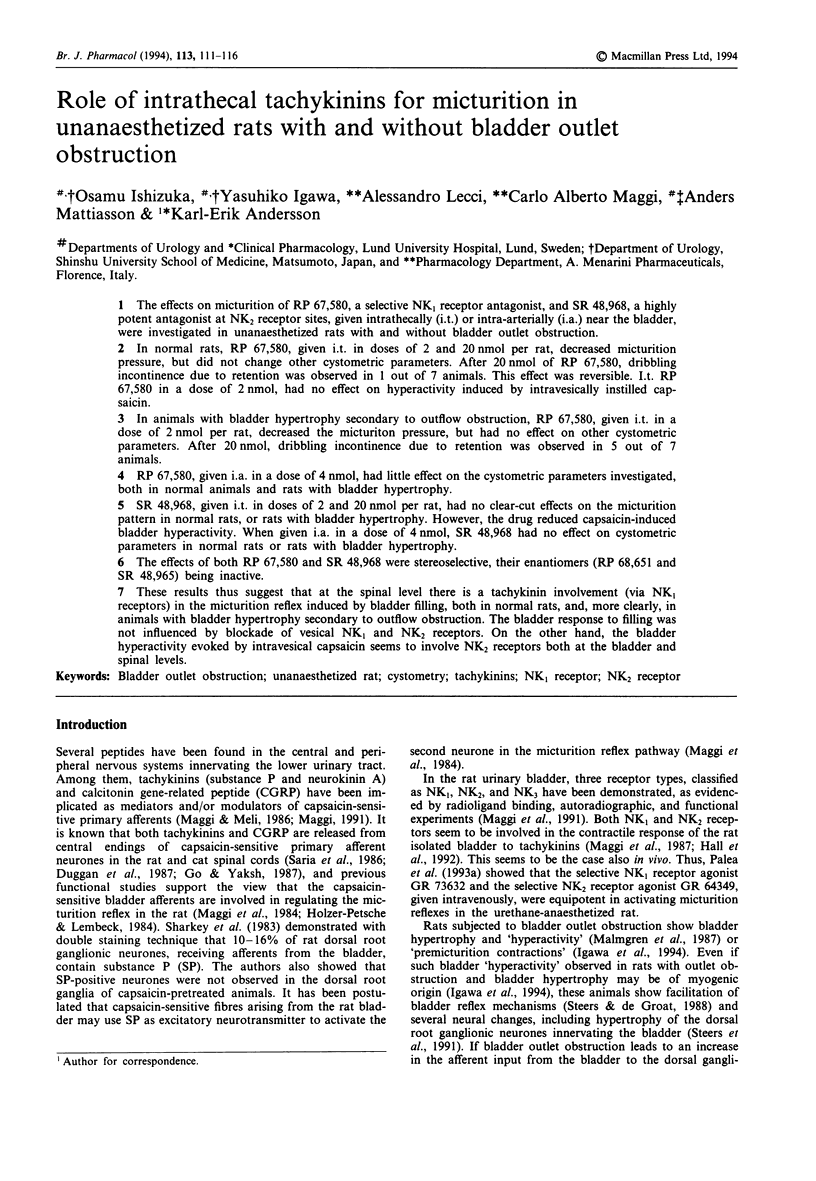
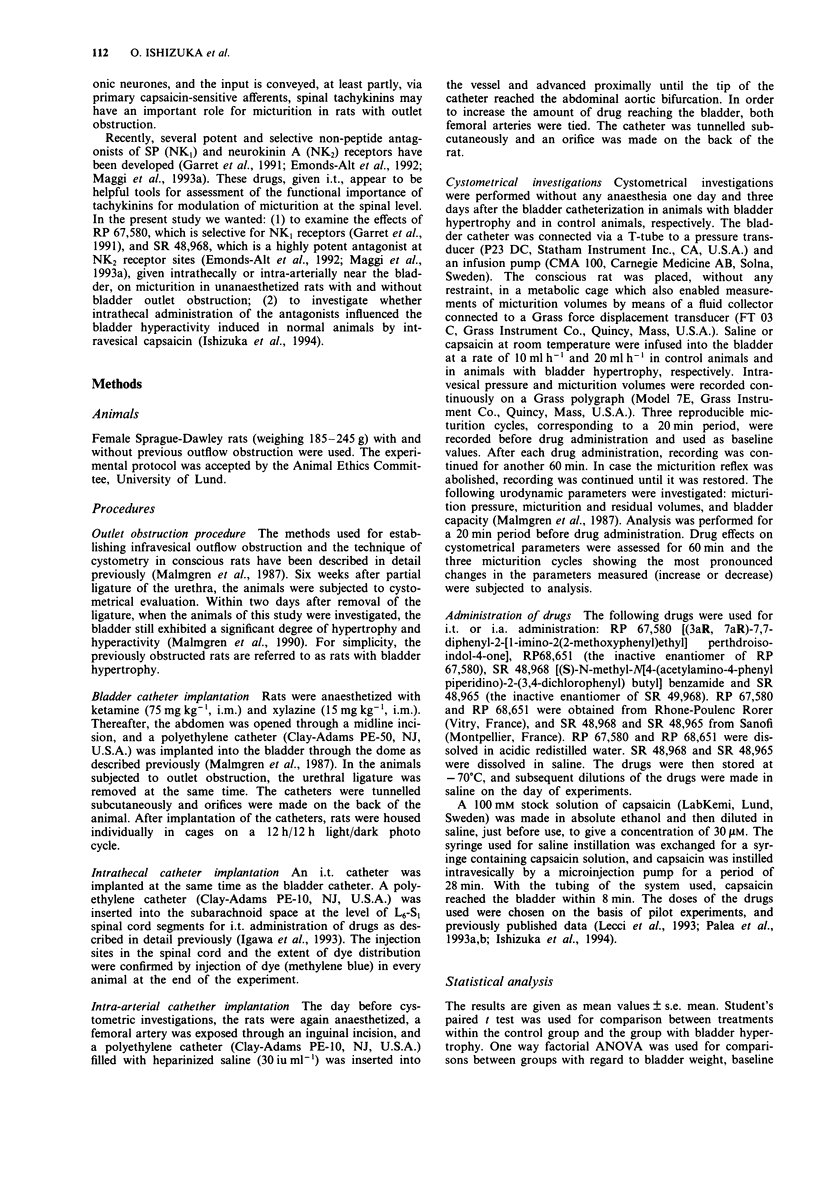
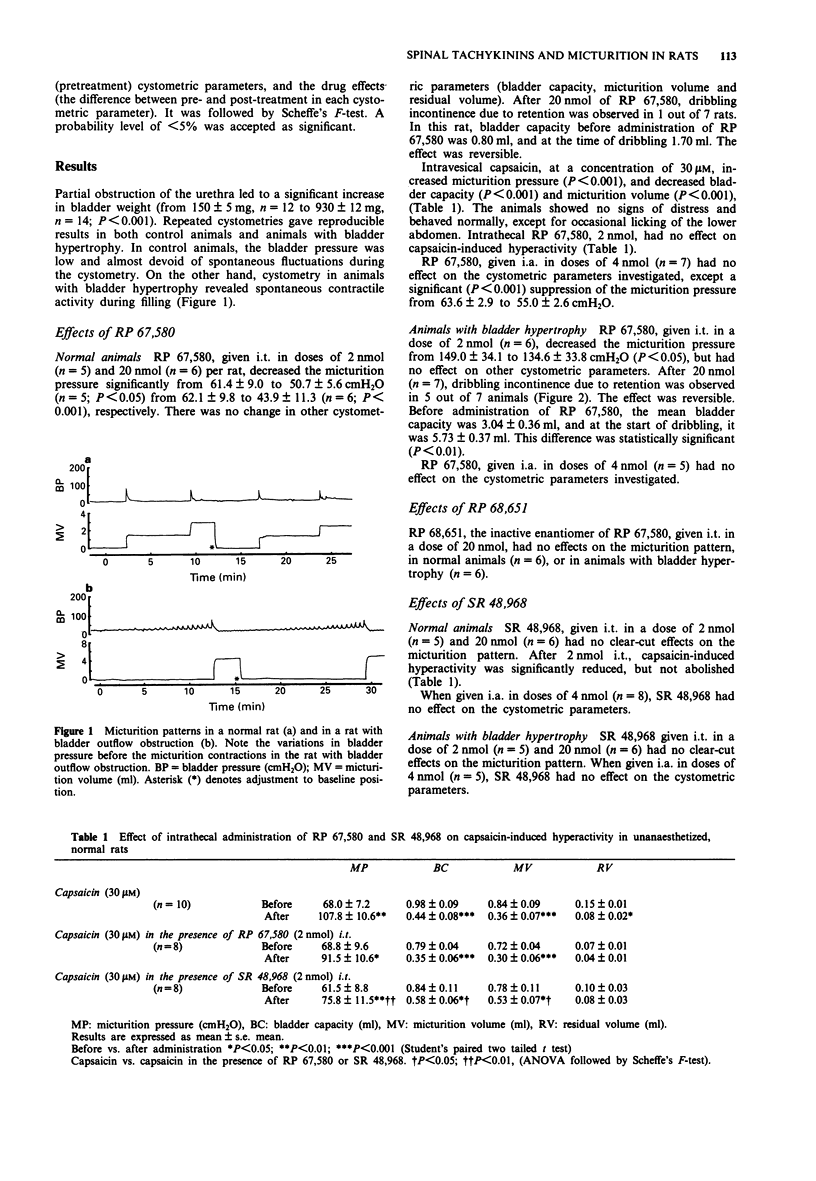
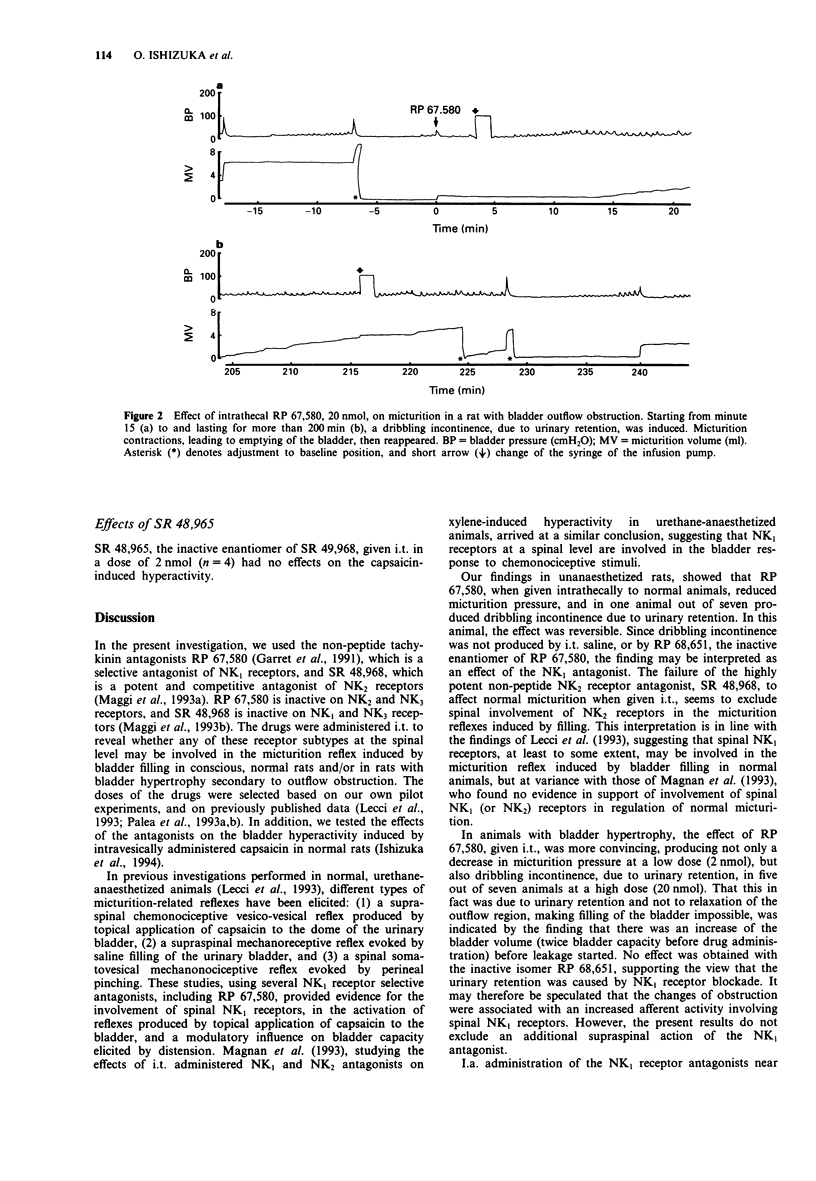
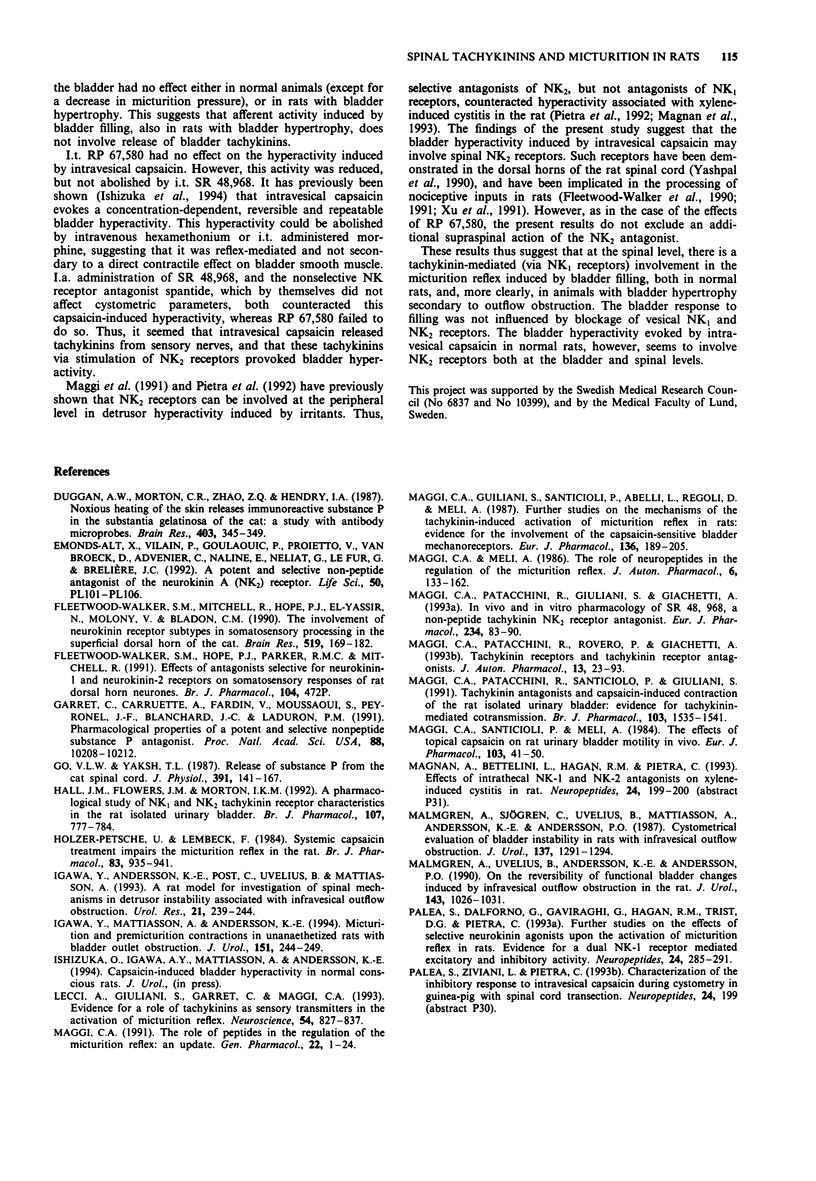
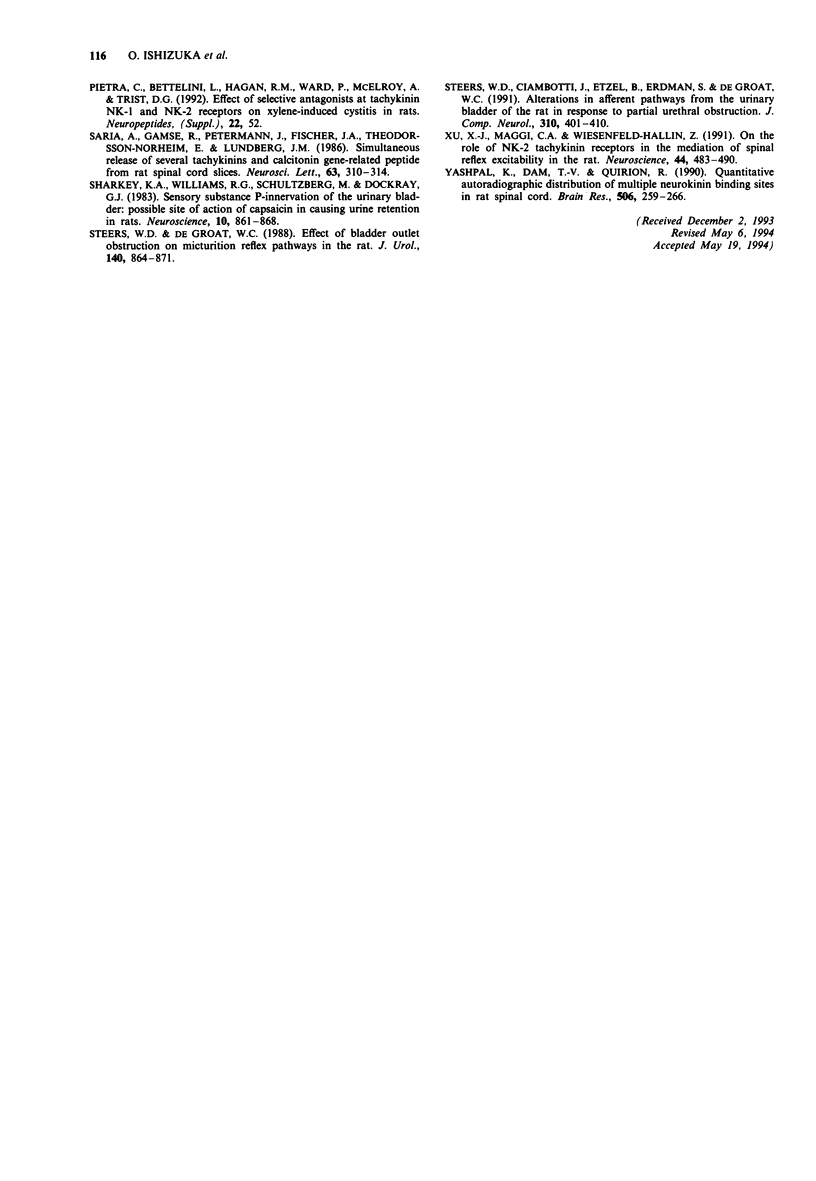
Selected References
These references are in PubMed. This may not be the complete list of references from this article.
- Duggan A. W., Morton C. R., Zhao Z. Q., Hendry I. A. Noxious heating of the skin releases immunoreactive substance P in the substantia gelatinosa of the cat: a study with antibody microprobes. Brain Res. 1987 Feb 17;403(2):345–349. doi: 10.1016/0006-8993(87)90073-4. [DOI] [PubMed] [Google Scholar]
- Emonds-Alt X., Vilain P., Goulaouic P., Proietto V., Van Broeck D., Advenier C., Naline E., Neliat G., Le Fur G., Brelière J. C. A potent and selective non-peptide antagonist of the neurokinin A (NK2) receptor. Life Sci. 1992;50(15):PL101–PL106. doi: 10.1016/0024-3205(92)90352-p. [DOI] [PubMed] [Google Scholar]
- Fleetwood-Walker S. M., Mitchell R., Hope P. J., El-Yassir N., Molony V., Bladon C. M. The involvement of neurokinin receptor subtypes in somatosensory processing in the superficial dorsal horn of the cat. Brain Res. 1990 Jun 11;519(1-2):169–182. doi: 10.1016/0006-8993(90)90075-m. [DOI] [PubMed] [Google Scholar]
- Garret C., Carruette A., Fardin V., Moussaoui S., Peyronel J. F., Blanchard J. C., Laduron P. M. Pharmacological properties of a potent and selective nonpeptide substance P antagonist. Proc Natl Acad Sci U S A. 1991 Nov 15;88(22):10208–10212. doi: 10.1073/pnas.88.22.10208. [DOI] [PMC free article] [PubMed] [Google Scholar]
- Go V. L., Yaksh T. L. Release of substance P from the cat spinal cord. J Physiol. 1987 Oct;391:141–167. doi: 10.1113/jphysiol.1987.sp016731. [DOI] [PMC free article] [PubMed] [Google Scholar]
- Hall J. M., Flowers J. M., Morton I. K. A pharmacological study of NK1 and NK2 tachykinin receptor characteristics in the rat isolated urinary bladder. Br J Pharmacol. 1992 Nov;107(3):777–784. doi: 10.1111/j.1476-5381.1992.tb14523.x. [DOI] [PMC free article] [PubMed] [Google Scholar]
- Holzer-Petsche U., Lembeck F. Systemic capsaicin treatment impairs the micturition reflex in the rat. Br J Pharmacol. 1984 Dec;83(4):935–941. doi: 10.1111/j.1476-5381.1984.tb16534.x. [DOI] [PMC free article] [PubMed] [Google Scholar]
- Igawa Y., Andersson K. E., Post C., Uvelius B., Mattiasson A. A rat model for investigation of spinal mechanisms in detrusor instability associated with infravesical outflow obstruction. Urol Res. 1993;21(4):239–244. doi: 10.1007/BF00307703. [DOI] [PubMed] [Google Scholar]
- Igawa Y., Mattiasson A., Andersson K. E. Micturition and premicturition contractions in unanesthetized rats with bladder outlet obstruction. J Urol. 1994 Jan;151(1):244–249. doi: 10.1016/s0022-5347(17)34925-x. [DOI] [PubMed] [Google Scholar]
- Lecci A., Giuliani S., Garret C., Maggi C. A. Evidence for a role of tachykinins as sensory transmitters in the activation of micturition reflex. Neuroscience. 1993 Jun;54(3):827–837. doi: 10.1016/0306-4522(93)90252-b. [DOI] [PubMed] [Google Scholar]
- Maggi C. A., Giuliani S., Santicioli P., Abelli L., Regoli D., Meli A. Further studies on the mechanisms of the tachykinin-induced activation of micturition reflex in rats: evidence for the involvement of the capsaicin-sensitive bladder mechanoreceptors. Eur J Pharmacol. 1987 Apr 14;136(2):189–205. doi: 10.1016/0014-2999(87)90711-4. [DOI] [PubMed] [Google Scholar]
- Maggi C. A., Meli A. The role of neuropeptides in the regulation of the micturition reflex. J Auton Pharmacol. 1986 Jun;6(2):133–162. doi: 10.1111/j.1474-8673.1986.tb00640.x. [DOI] [PubMed] [Google Scholar]
- Maggi C. A., Patacchini R., Giuliani S., Giachetti A. In vivo and in vitro pharmacology of SR 48,968, a non-peptide tachykinin NK2 receptor antagonist. Eur J Pharmacol. 1993 Mar 30;234(1):83–90. doi: 10.1016/0014-2999(93)90709-q. [DOI] [PubMed] [Google Scholar]
- Maggi C. A., Patacchini R., Rovero P., Giachetti A. Tachykinin receptors and tachykinin receptor antagonists. J Auton Pharmacol. 1993 Feb;13(1):23–93. doi: 10.1111/j.1474-8673.1993.tb00396.x. [DOI] [PubMed] [Google Scholar]
- Maggi C. A., Patacchini R., Santicioli P., Giuliani S. Tachykinin antagonists and capsaicin-induced contraction of the rat isolated urinary bladder: evidence for tachykinin-mediated cotransmission. Br J Pharmacol. 1991 Jun;103(2):1535–1541. doi: 10.1111/j.1476-5381.1991.tb09823.x. [DOI] [PMC free article] [PubMed] [Google Scholar]
- Maggi C. A., Santicioli P., Meli A. The effects of topical capsaicin on rat urinary bladder motility in vivo. Eur J Pharmacol. 1984 Aug 3;103(1-2):41–50. doi: 10.1016/0014-2999(84)90187-0. [DOI] [PubMed] [Google Scholar]
- Maggi C. A. The role of peptides in the regulation of the micturition reflex: an update. Gen Pharmacol. 1991;22(1):1–24. doi: 10.1016/0306-3623(91)90304-o. [DOI] [PubMed] [Google Scholar]
- Malmgren A., Sjögren C., Uvelius B., Mattiasson A., Andersson K. E., Andersson P. O. Cystometrical evaluation of bladder instability in rats with infravesical outflow obstruction. J Urol. 1987 Jun;137(6):1291–1294. doi: 10.1016/s0022-5347(17)44485-5. [DOI] [PubMed] [Google Scholar]
- Malmgren A., Uvelius B., Andersson K. E., Andersson P. O. On the reversibility of functional bladder changes induced by infravesical outflow obstruction in the rat. J Urol. 1990 May;143(5):1026–1031. doi: 10.1016/s0022-5347(17)40176-5. [DOI] [PubMed] [Google Scholar]
- Palea S., Dalforno G., Gaviraghi G., Hagan R. M., Trist D. G., Pietra C. Further studies on the effects of selective neurokinin agonists upon the activation of micturition reflex in rats. Evidence for a dual NK-1 receptor mediated excitatory and inhibitory activity. Neuropeptides. 1993 May;24(5):285–291. doi: 10.1016/0143-4179(93)90017-5. [DOI] [PubMed] [Google Scholar]
- Saria A., Gamse R., Petermann J., Fischer J. A., Theodorsson-Norheim E., Lundberg J. M. Simultaneous release of several tachykinins and calcitonin gene-related peptide from rat spinal cord slices. Neurosci Lett. 1986 Jan 30;63(3):310–314. doi: 10.1016/0304-3940(86)90376-9. [DOI] [PubMed] [Google Scholar]
- Sharkey K. A., Williams R. G., Schultzberg M., Dockray G. J. Sensory substance P-innervation of the urinary bladder: possible site of action of capsaicin in causing urine retention in rats. Neuroscience. 1983 Nov;10(3):861–868. doi: 10.1016/0306-4522(83)90223-3. [DOI] [PubMed] [Google Scholar]
- Steers W. D., Ciambotti J., Etzel B., Erdman S., de Groat W. C. Alterations in afferent pathways from the urinary bladder of the rat in response to partial urethral obstruction. J Comp Neurol. 1991 Aug 15;310(3):401–410. doi: 10.1002/cne.903100309. [DOI] [PubMed] [Google Scholar]
- Steers W. D., De Groat W. C. Effect of bladder outlet obstruction on micturition reflex pathways in the rat. J Urol. 1988 Oct;140(4):864–871. doi: 10.1016/s0022-5347(17)41846-5. [DOI] [PubMed] [Google Scholar]
- Xu X. J., Maggi C. A., Wiesenfeld-Hallin Z. On the role of NK-2 tachykinin receptors in the mediation of spinal reflex excitability in the rat. Neuroscience. 1991;44(2):483–490. doi: 10.1016/0306-4522(91)90071-u. [DOI] [PubMed] [Google Scholar]
- Yashpal K., Dam T. V., Quirion R. Quantitative autoradiographic distribution of multiple neurokinin binding sites in rat spinal cord. Brain Res. 1990 Jan 8;506(2):259–266. doi: 10.1016/0006-8993(90)91260-n. [DOI] [PubMed] [Google Scholar]


